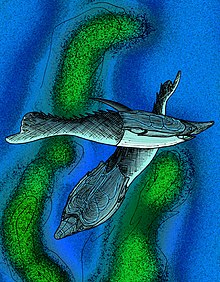Pteraspis
You can help expand this article with text translated from the corresponding article in German. (September 2020) Click [show] for important translation instructions.
|
| Pteraspis | |
|---|---|

| |
| Restoration of P. rostrata | |
| Scientific classification | |
| Domain: | Eukaryota |
| Kingdom: | Animalia |
| Phylum: | Chordata |
| Infraphylum: | Agnatha |
| Class: | †Pteraspidomorphi |
| Subclass: | †Heterostraci |
| Order: | †Pteraspidiformes |
| Family: | †Pteraspididae |
| Genus: | †Pteraspis Kner, 1847 |
| Type species | |
| Cephalaspis rostrata Agassiz, 1835
| |
| Species | |
| |
Pteraspis (from Greek: πτερόν pteron 'wing' or 'fin' and Greek: ἀσπίς aspís 'shield') is an extinct genus of pteraspidid heterostracan agnathan vertebrate that lived from the Lochkovian to Eifelian epochs of the Devonian period in what is now Brazil (Eifelian Maecuru Formation), Britain (Lochkovian Ditton Group), Ukraine (Lochkovian Ivane Suite, Pragian Babin Sandstone) and Belgium.[citation needed]
Description[edit]


Like other heterostracan fishes, Pteraspis had a protective armored plating covering the front of its body. Though lacking fins other than its lobed tail, it is thought to have been a good swimmer thanks to stiff, wing-like protrusions derived from the armoured plates over its gills. This, along with the horn-like rostrum, made Pteraspis very streamlined in shape; a perfect quality for a good swimmer. Pteraspis also had some stiff spikes on its back, possibly an additional form of protection against predators. It is thought to have fed from shoals of plankton just under the ocean surface,[1] and some records are found in association with marine fossils,[2][3] while some others are found in freshwater environment.[4]
Pteraspis grew to an estimated length of 20 centimetres (7.9 in).
References[edit]
- ^ Palmer, D., ed. (1999). The Marshall Illustrated Encyclopedia of Dinosaurs and Prehistoric Animals. London: Marshall Editions. p. 23. ISBN 1-84028-152-9.
- ^ Lankester, E. R. (1870). "I.—On a New Cephalaspis Discovered in America, etc". Geological Magazine. 7 (75): 397–399. Bibcode:1870GeoM....7..397L. doi:10.1017/S0016756800209485. S2CID 140161565.
- ^ White, E. I. (1938). "New Pteraspids from South Wales". Quarterly Journal of the Geological Society. 94 (1–4): 85–116. doi:10.1144/GSL.JGS.1938.094.01-04.05. S2CID 130276490.
- ^ Davies, Benjamin Evan (2009-07-03). An experimental morphological investigation into the hydrodynamics and locomotion of the Palaeozoic jawless vertebrates Poraspis, Errivaspis and Ateleaspis (thesis thesis). University of Leicester.
- Pteraspidiformes genera
- Devonian jawless fish
- Early Devonian fish
- Early Devonian genus first appearances
- Lochkovian life
- Pragian life
- Emsian life
- Eifelian life
- Middle Devonian genus extinctions
- Early Devonian fish of Europe
- Devonian England
- Fossils of England
- Paleozoic Ukraine
- Fossils of Ukraine
- Devonian animals of South America
- Devonian Brazil
- Fossils of Brazil
- Fossil taxa described in 1835
- Fossil taxa described in 1847
- Taxa named by Louis Agassiz
- Pteraspidomorphi stubs
- Devonian jawless fish stubs
